Daisy Delight |
||||||||||||||||||||||
 |
 |
|||||||||||||||||||||
Knitted jumper with round yoke in DROPS BabyMerino. Piece is knitted top down with Nordic pattern and garter stitch. Size: S - XXXL
DROPS 196-2 |
||||||||||||||||||||||
|
EXPLANATION FOR THE PATTERN: ---------------------------------------------------------- GARTER STITCH (worked in the round): 1 ridge = 2 rounds. Knit 1 round and purl 1 round. PATTERN: See diagrams A.1 to A.3. Choose diagram for your size (applies to A.1). KNITTING TIP: To avoid the garment losing elasticity when working pattern, it is important not to tighten the strands on back side of piece. Switch to a higher needle number when working pattern if the pattern is somewhat tight. INCREASE TIP-1 (evenly): To calculate how to increase evenly, use the total number of stitches on row (e.g. 106 stitches) and divide stitches by number of increases to be done (e.g. 4) = 26.5. In this example increase by making 1 yarn over after alternately every 26th and 27th stitch. On next round work yarn over twisted to avoid hole. INCREASE TIP-2 (applies to sides of body): Work until 8 stitches remain before marker thread, make 1 yarn over, knit 16 (marker thread is in the middle of these stitches), make 1 yarn over. On next round knit yarn over twisted to avoid holes. ELEVATION: Insert a marker thread mid back = beginning of round. Begin from right side with plum and work in stocking stitch until 8-8-8-9-9-10 stitches have been worked past marker, turn, tighten yarn and work 16-16-16-18-18-20 stitches in stocking stitch. Turn, tighten yarn and work 24-24-24-27-27-30 stitches in stocking stitch, turn, tighten yarn and work 32-32-32-36-36-40 stitches in stocking stitch, turn, tighten yarn and work until mid back. RAGLAN: Increase 1 stitch on each side of every marker thread (= 8 stitches increased on round) as follows: Work until 1 stitch remains before marker thread, make 1 yarn over, knit 2 (marker thread is between these stitches), make 1 yarn over. Repeat at the other marker threads. On next round work yarn overs twisted to avoid holes. DECREASE TIP (applies to sleeves): Decrease 1 stitch on each side of marker thread as follows: Work until 3 stitches remain before marker thread and knit 2 together, knit 2 (marker thread is between these stitches), slip 1 stitch knitwise, knit 1, pass slipped stitch over stitch worked. ---------------------------------------------------------- START THE PIECE HERE: ---------------------------------------------------------- JUMPER - SHORT OVERVIEW OF THE PIECE: Worked in the round on circular needle, top down. Work sleeves in the round on double pointed needles/a short circular needle. NECK EDGE: Cast on 106-110-115-125-130-134 stitches on a short circular needle size 2.5 mm with plum. Work 5 ridges in GARTER STITCH - read explanation above. YOKE: Switch to circular needle size 3 mm. Knit 1 round while increasing 4-10-15-15-20-26 stitches evenly - read INCREASE TIP-1 = 110-120-130-140-150-160 stitches. Knit 1 round (all stitches are knitted twisted to avoid holes). For better fit work an elevation at the back of neck so that yoke is somewhat higher on back piece. This elevation can be skipped, to make the neck the same at the front and back - read ELEVATION. Insert 9-10-10-10-11-11 marker threads in piece without working as follows: Insert first marker thread after 7-6-7-7-5-5 stitches, insert each of the next 8-9-9-9-10-10 marker threads after 12-12-13-14-14-15 stitches, 7-6-6-7-5-5 stitches remain on round after last marker thread. Move the marker threads upwards when working. Now work pattern A.1 (choose diagram for your size) the entire round – read KNITTING TIP, AT THE SAME TIME on every round with arrow in diagram increase on each side of marker threads as follows: REMEMBER THE KNITTING TENSION! ARROW-1: Increase 1 stitch on each side of every marker thread (= 18-20-20-20-22-22 stitches increased) = 128-140-150-160-172-182 stitches. ARROW-2: Increase 1 stitch on each side of every marker thread (= 18-20-20-20-22-22 stitches increased) = 146-160-170-180-194-204 stitches. ARROW-3: Increase 1 stitch on each side of every marker thread (= 18-20-20-20-22-22 stitches increased) = 164-180-190-200-216-226 stitches. ARROW-4: Increase 1 stitch on each side of every marker thread (= 18-20-20-20-22-22 stitches increased) = 182-200-210-220-238-248 stitches. ARROW-5: Increase 1 stitch on each side of every marker thread (= 18-20-20-20-22-22 stitches increased) = 200-220-230-240-260-270 stitches. When entire A.1 has been worked vertically, piece measures approx. 11-12-13-14-15-16 cm from cast-on edge and down mid front. Remove the marker threads. Now work pattern A.2 (= 20-22-23-24-26-27 repetitions of 10 stitches) in the round. On next to last round in A.2 increase 10-12-14-16-12-12 stitches evenly = 290-320-336-352-376-390 stitches. When entire A.2 has been worked vertically, piece measures approx. 19-20-21-22-23-24 cm from cast-on edge and down mid front. Now insert 4 marker threads in the piece as follows: Insert 1st marker thread after the first 45-49-51-55-60-64 stitches (= half back piece), insert 2nd marker thread after the next 55-62-66-66-68-67 stitches (= sleeve), insert 3rd marker thread after the next 90-98-102-110-120-128 stitches (= front piece) and insert 4th marker thread after the next 55-62-66-66-68-67 stitches (= sleeve). 45-49-51-55-60-64 stitches remain on round after last marker thread (= half back piece). Now work pattern A.3 in the round, at the same time on first round begin increase for RAGLAN – read explanation above. Increase like this every other round 5-6-8-10-11-13 times in total = 330-368-400-432-464-494 stitches. NOTE: When A.3 has been worked vertically 1 time, continue with stocking stitch until all increases for raglan are done and piece measures 22-24-26-28-30-32 cm from cast-on edge. Work next round as follows: 50-55-59-65-71-77 stitches in stocking stitch (= half back piece), slip the next 65-74-82-86-90-93 stitches on 1 stitch holder for sleeve, cast on 10-10-12-12-14-16 new stitches on row (= in the side under sleeve), work 100-110-118-130-142-154 stitches in stocking stitch (= front piece), slip the next 65-74-82-86-90-93 stitches on 1 stitch holder for sleeve edges, cast on 10-10-12-12-14-16 new stitches on row (= in the side under sleeve) and work the remaining 50-55-59-65-71-77 stitches in stocking stitch (= half back piece). Finish body and sleeves separately. NOW MEASURE THE PIECE FROM HERE! BODY: = 220-240-260-284-312-340 stitches. Insert 1 marker thread in each side in the middle of the 10-10-12-12-14-16 stitches cast on under each sleeve (= 110-120-130-142-156-170 stitches between marker threads). Continue in the round with plum and in stocking stitch. When piece measures 4 cm from division, increase 2 stitches in each side - read INCREASE TIP-2 (= 4 stitches increased). Increase like this approx. every 2 cm 12 times in total = 268-288-308-332-360-388 stitches. Work the new stitches in stocking stitch. When piece measures 28 cm from division, increase 8-12-13-13-15-17 stitches = 276-300-321-345-375-405 stitches. Switch to circular needle size 2.5 mm. Work rib * knit 1, 2 stitches in garter stitch *, work from *-* in the round for 2 cm. Work 2 ridges and cast off. Jumper measures approx. 56-58-60-62-64-66 cm from shoulder and down. SLEEVE: Slip the 65-74-82-86-90-93 stitches from stitch holder in one side of piece on double pointed needles or a short circular needle size 3 mm and pick in addition up 1 stitch in each of the 10-10-12-12-14-16 new stitches cast on under sleeve = 75-84-94-98-104-109 stitches. Insert 1 marker thread in the middle of the 10-10-12-12-14-16 stitches mid under sleeve and begin round here. Continue with plum and in stocking stitch. When piece measures 4 cm, decrease 2 stitches mid under sleeve - read DECREASE TIP. Decrease like this every 8th-6th-5th-4th-4th-3rd round 13-17-21-22-23-24 times in total = 49-50-52-54-58-61 stitches. Continue until piece measures 40-38-37-35-33-32 cm from division (shorter measurements in the larger sizes because of wider neck and longer yoke). Knit 1 round while increasing 2-4-5-6-5-5 stitches evenly = 51-54-57-60-63-66 stitches. Switch to double pointed needles size 2.5 mm. Now work rib * knit 1, 2 stitches in garter stitch *, work from *-* in the round for 2 cm. Work 2 ridges and cast off. Work the other sleeve the same way. |
||||||||||||||||||||||
Diagram explanations |
||||||||||||||||||||||
|
||||||||||||||||||||||

|
||||||||||||||||||||||

|
||||||||||||||||||||||
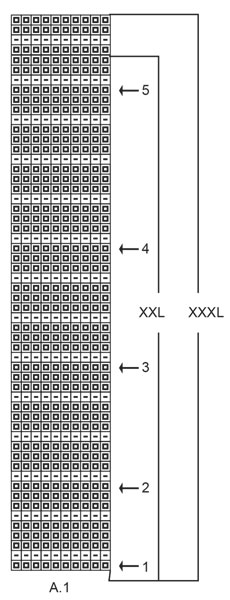
|
||||||||||||||||||||||
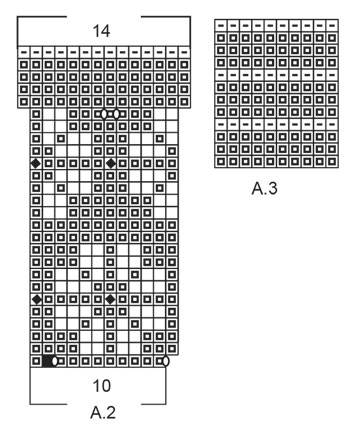
|
||||||||||||||||||||||
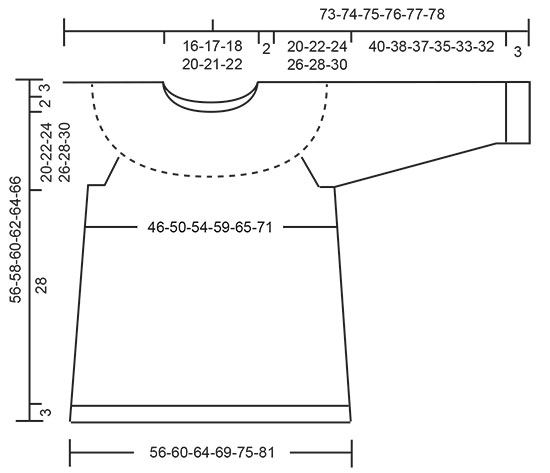
|
||||||||||||||||||||||
|
Have you made this or any other of our designs? Tag your pictures in social media with #dropsdesign so we can see them! Do you need help with this pattern?You'll find tutorial videos, a Comments/Questions area and more by visiting the pattern on garnstudio.com. © 1982-2024 DROPS Design A/S. We reserve all rights. This document, including all its sub-sections, has copyrights. Read more about what you can do with our patterns at the bottom of each pattern on our site. |
||||||||||||||||||||||








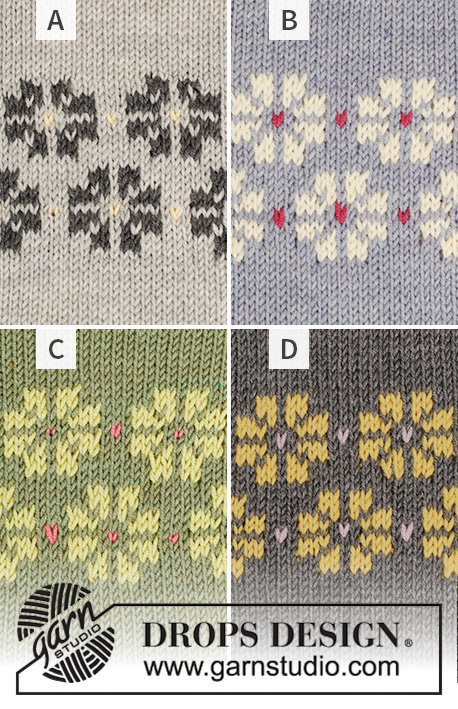
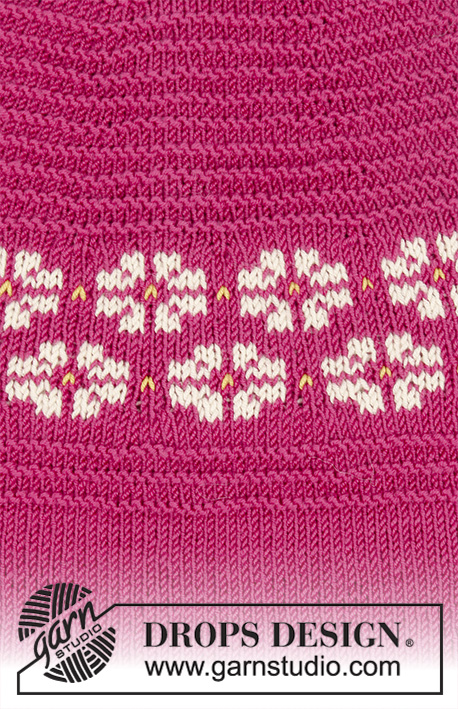


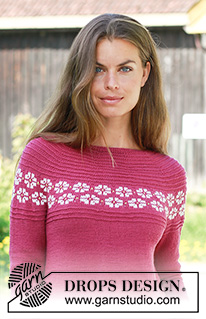






















































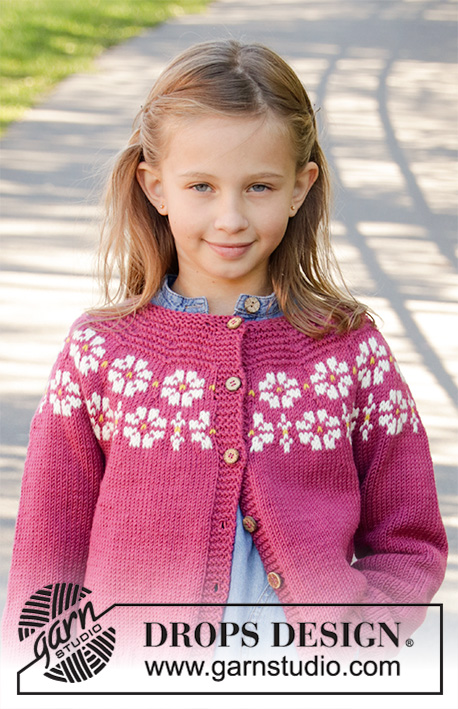

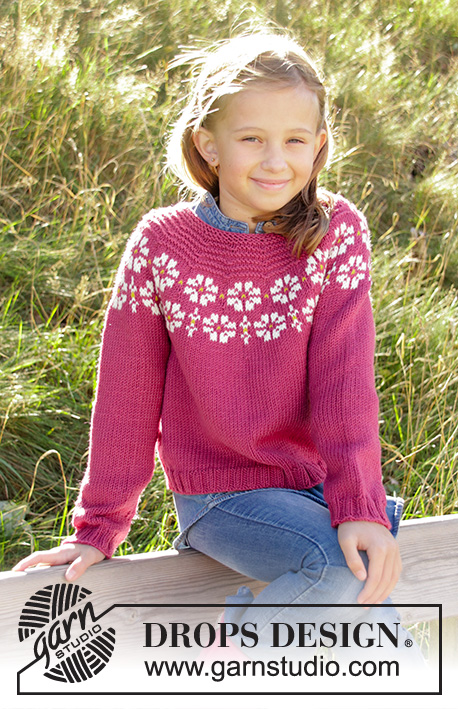






Comments / Questions (55)
St xxl A1 er strikket færdig, der er 260 m på rundpinden. A2 mønster, 26 rapporter a 10 m. På næstsidste omgang tages 12 masker ud jævnt fordelt, 272 m. Hvordan bliver det til 376 m??? Tror ikke jeg forstår mønsteret, skal der tages ud i mønsteret?
19.07.2021 - 07:12DROPS Design answered:
Hej Helle, husk at du skal tage ud ifølge diagram A.2, 2 udtagninger på første pind x 26 og på pind 24 igen 2 masker ud x 26 = ialt 376 masker
04.08.2021 - 11:57Excelentemente bien explicado. Lo estoy realizando en talla S y me esta quedando lindisimo.
03.07.2021 - 06:25Per ongeluk heb ik mijn vraag als opmerking gestuurd. Dus nogmaals dank en begin ik A2 middenachter? 4 oorspronkelijk was dit het begin vd naald.
12.12.2020 - 08:37DROPS Design answered:
Dag Bianca,
Ja, klopt, A.2 begint midden achter; dit is het begin van de naald.
17.12.2020 - 23:30Hi Drops, dank voor het patroon. Begin ik A2 bij het begin vd ronde (middenachter?). Dank u bij voorbaat, groet,
12.12.2020 - 08:35J’ai imprimé le patron 196-2 et il a sûrement un erreur dans le calcul des mailles à partir de À.2 jusqu’à la fin du Dos&Devant
17.09.2020 - 20:14DROPS Design answered:
Bonjour Nicole, à quelle erreur pensez-vous précisément? Quelle taille et quel niveau des explications? Merci pour ces informations complémentaires.
18.09.2020 - 08:54Here I am again. For A2, pattern reads “23 repetitions of 10 stitches” but I count 12 stitches per repetition in A2 after the first row. Is this correct?
09.07.2020 - 19:19DROPS Design answered:
Hi Sue, Yes, you are right, after row 1 there are 12 stitches in each A.2. So on row 1, you increase 23 x 2 = 46 stitches. Happy knitting!
10.07.2020 - 07:15Ok I give up. On the A2 chart for the Daisy sweater, what does the little football shaped symbol mean in the first row?
25.06.2020 - 03:06DROPS Design answered:
Dear Mrs Craver, this symbol is the 5th from diagram key, it's a yarn over - to increase for round yoke in A.2 you will make some yarn overs on first row 5 = 2 yarn overs) and on 21sts row (so that there will be 14 sts in each A.2). Happy knitting!
25.06.2020 - 09:06Pattern 196-2, can the size S be knit with Sublime baby cashmere merino silk dk yarn with size 3 needles? My granddaughter picked out the yarn and I don’t know how to determine if it could be substituted.
17.05.2020 - 08:18DROPS Design answered:
Hi Sue, You will need to do a swatch to see how many rows and stitches you need to get 4 x 4" and then adjust the numbers in the pattern accordingly. Happy knitting!
19.05.2020 - 08:10In reading the chart for Daisy Delight 196-2, the A-1 chart for size S has a blank row at the bottom. What does this represent?
17.05.2020 - 02:40DROPS Design answered:
Hi Sue, The first row in A.1 for both sizes S and M is a knit row with Plum. Happy knitting!
18.05.2020 - 08:07I want to make this for my 12 year old granddaughter. I just knit the daisy delight pattern for her and it was 2 sizes too small. Her chest measurement is 29 1/2 inches. What size should I knit for her in this pattern? I’m not sure if measurements are in inches or centimeters.
14.05.2020 - 03:22DROPS Design answered:
Dear Mrs Craver, this pattern is available in children size to 12 years - see Daisy Delight. Measurements in chart are all in cm. Happy knitting!
14.05.2020 - 08:01